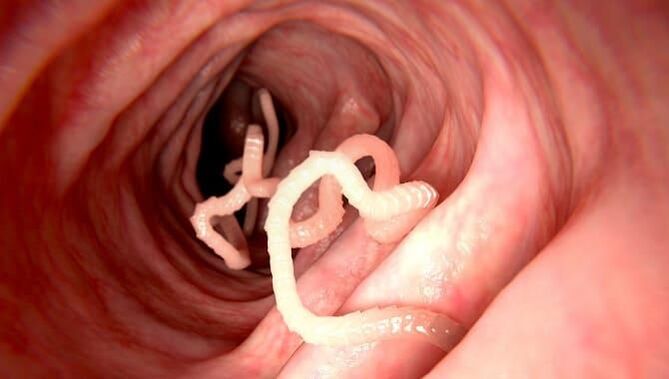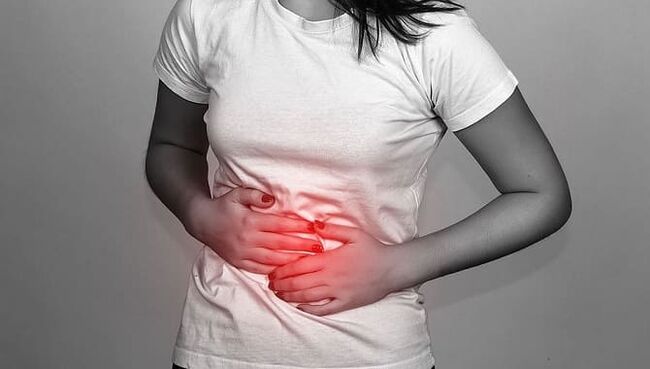Symptoms of worms in humans cannot always be detected in time. Worm infestations often have symptoms similar to other illnesses, such as allergies or indigestion. Helminths parasitize in different parts of the human body. An infected person can treat liver failure, a chronic cold or dermatosis without knowing the real cause of ill health.
What are helminths?
Human worms are parasitic worms that can vary in size. They can enter the human body through the mouth, nasal passages, eyes, urethra or anus. Most often, parasites live in the intestines, attached to its walls using rubber cups, tentacles or peculiar teeth. Parasites can live in the tissues of the lungs and brain, on the mucous membrane of the respiratory tract, in the muscles, liver and gall bladder.

Classification of helminthiasis: types of worms in humans
Different types of helminths can parasitize the human body. Medical helminthology divides them into groups taking into account the specificity of the body shape:
- round (nematodes)- have a holistic shape in the shape of a lemon, a thread, a barrel or a spindle. The head and tail of nematodes are slightly pointed. The oral appliance is characterized as three-layered. Parasites move freely in soil, fresh and sea water. The human body contains pinworms (which cause enterobiasis), roundworms, hookworms and trichinella, which are considered intestinal parasites. Guinea worms - these round worms spread through the subcutaneous tissue.
- tape. This includes the following types of parasites: bovine, porcine, dwarf tapeworm, broad tapeworm. Their body resembles a finely segmented cord, the length of which can reach 10 meters or more. The front part of the parasitic worms is equipped with vacuum cups and hooks with which they attach to the walls of the intestine. Echinococci have a complex fixation system - 4 teats surrounded by two rows of hooks.
- trematodes (flukes)— this type of worm is characterized by specific habitats in the body: gall bladder, bile ducts. Representatives of the fluke class are Siberian fluke (4-13 mm), fasciola (length 3-7 cm).

How to get infected with helminths?
Everyone should know why worms appear in people and where they live in the body:
- Nematodes and dwarf tapeworm enter the body through dirty hands, eating unwashed vegetables and drinking dirty water. Habitat: intestines.
- Trichinella, beef, pork tapeworm - infection occurs when eating thermally poorly processed meat (beef, pork). Location: intestines.
- Opisthorchis, broad tapeworm (class of trematodes or tapeworms). A person can become infected if he eats raw, lightly salted or undercooked fish. In fish, parasite larvae live in the fat layer and muscles. In humans, they are deposited in the liver and gall bladder.
- Echinococcus, Siberian fluke, fasciola are transmitted by contact with an infected dog; less often, cats are the source of infection. Helminths can parasitize the human liver, lungs, kidneys and heart. They develop inside echinococcal cysts.
What do worms look like in human stool?
A person may see dead roundworms in the feces 3-4 days after taking anthelmintic tablets. The length of these parasites that live in the human body can reach 40 cm, their edges are sharp, and their bodies are white.
Pinworms usually leave the body alive a few hours after consuming milk with garlic, too salty or spicy food. Small white worms (up to 12 mm long) with sharp edges are clearly visible in the stool and around the anus.
Large flatworms or tapeworms are almost impossible to see completely (3 to 10 m long). After being baited, the worms come out of the body in rotten pieces.
Signs of the presence of worms in humans
In case of helminthic infestation, the symptoms in adults and children usually resemble the manifestations of other diseases. This is due to the location (respiratory tract, liver, bile) and life process of the worm.
During the acute period
The acute phase is considered to be asymptomatic. But in most cases, the first signs of worms are mild, and the person ignores the parasitic disease. Less often, an infected person shows signs of helminthiasis in the body with fever, nausea and vomiting. The person feels weak and loses appetite.
In the chronic phase
Symptoms of chronic helminthosis depend on the type of worms, their number and habitat.
Intestinal helminthiasis
Symptoms of adult intestinal worms:
- deterioration of digestion;
- pressure pain in the navel area;
- bowel dysfunction;
- lack of appetite;
- weight loss;
- pale skin;
- bruises under the eyes;
- anal itching.

Extraintestinal helminthiasis
The main signs of infection with helminths of the liver, gallstones and lungs:
- constant fatigue;
- nervous breakdown;
- paroxysmal pain in the epigastric region;
- reduced performance;
- smelly, greasy stools (steatorrhea);
- urticaria, itching of the skin;
- chest pain;
- chronic dry cough;
- skin discoloration.
Extraintestinal parasites (giardia, opisthorchis, fasciola) can cause not only headaches or skin diseases, but also depression. Typically, a pathological condition occurs if skin allergy symptoms do not disappear for a long time (itching, dry skin, rash) or reappear after treatment.
How to detect worms: diagnosis of helminthic infestations
To diagnose helminths, stool is collected on worm eggs. But the analysis does not always show a positive result in the presence of parasites. First, not all types of worms are determined in this way. Second, the time of stool submission for analysis may not coincide with the time of parasite reproduction. A repeated test for worm eggs is done after 2-3 days. If the result in the presence of symptoms is negative, then the following test methods can be prescribed:
- Blood analysis- increased level of eosinophilic leukocytes and low hemoglobin indicate worm infection.
- Duodenal sounding- helps in the identification of opisthorchiasis, giardiasis and other extraintestinal worms in humans by examining secretions from the duodenum.
- Ultrasound of the abdominal cavity and other parts of the human body— the gastrointestinal tract, liver, gall bladder, its ducts, pancreas, muscles, brain, lungs are examined for the presence of pathological changes characteristic of the life of worms (seals, cysts, nodes, blockages).
- Chest X-ray- performed if lung parasites are suspected (roundworms, echinococcus, tapeworm larvae were detected).
- CT scanner- to detect worms in the human brain, eyes and lungs.
- Capsule endoscopy— to identify tapeworms.
- ELISA— detects antibodies in the blood against most known parasites.
In order to assess the severity of damage to the body from worms, an immunological study is prescribed. It helps to identify weaknesses in the human immune system. After that, complex therapy of the pathological condition is prescribed.
How to get rid of worms quickly and effectively
It is better to learn how to remove helminths from the human body at an examination by a parasitologist. Treatment of worms without medical advice can lead to intoxication and liver dysfunction.
Diet and hygiene characteristics
Treatment of helminthiasis in adults and children should be accompanied by a diet that will help quickly remove worms and cleanse the body of toxins. Products that contribute to the vital activity of parasites or body intoxication should be excluded from the menu:
- meat, fat;
- all kinds of sweets;
- fresh milk;
- bakery products;
- wheat porridge, pasta;
- coffee, alcohol.

Hygienic procedures for helminthic infestation include frequent and thorough hand washing with soap. The procedure must be performed before eating, after going to the toilet and after returning from the street. Bed linen is changed 2-3 times a week. Be sure to iron after washing. After bathing, take a clean towel each time.
Medicines
Treatment of worms in adults and children is carried out with the following drugs:
- Broad-spectrum benzimidazole-type anthelmintic drug - effective against nematodes and trematodes. Contraindicated in children under 2 years of age, prescribed with caution to pregnant and lactating women. Dosage and frequency of taking the drug depend on the type of worm. For roundworms and mixed infestations, 1 tablet is prescribed. 2 times a day for three days. Enterobiosis is treated for three days in a row, taking 1 tablet a day. The course is repeated after 21 days. Echinococci in an adult are eliminated by increasing the dose of the drug: the first 3 days - 500 mg in the morning and in the evening, the next three days - 500 mg three times a day until complete recovery from the parasite. The duration of treatment for echinococcosis is determined by the doctor (from 4 to 6 weeks).
- Broad-spectrum anthelmintic drug from the pyrazinisoquinoline group. Contraindicated for children under 4 years of age and pregnant women (1st trimester). Effective against muscle/tissue worms. Urogenital schistosomiasis (worms live in blood vessels near the bladder), intestinal and abdominal schistosomiasis are treated with a single dose of the drug (40 mg/10 kg). In severe forms of parasitic vascular pathology, tablets are taken 3 times a day (every 6 hours) in a dose of 20-25 mg/10 kg.
- A broad-spectrum drug from the benzimidazole group. It is not prescribed for children under 2 years of age, pregnant and lactating women. Adults are prescribed 400 mg/day once, children in a dose of 60 mg/10 kg for intestinal helminthosis. For parasites in the brain, adults are prescribed 800 mg/day, children - 15 mg/kg, the course of treatment is 8-30 days.
Anthelmintic drugs are toxic. They are not prescribed to people with liver failure, ulcerative colitis or Crohn's disease.
Traditional methods
How to cure worms with home remedies:
- Grind flax seeds (1 tablespoon). Pour the powder into 0. 5 liters of cold water. Bring the mixture to a boil, cook over low heat, covered, for 20 minutes. Drink 100 ml in the morning and in the evening on an empty stomach for 10 days in a row. The recipe helps against almost all parasites that can live in the human body - pinworms, tapeworms, Giardia.
- Grind 300 g of dried but not roasted pumpkin seeds. Add enough warm boiled water to the powder to make a paste. Add a large spoonful of honey. Eat the whole mixture on an empty stomach. After 4 hours, take a laxative. The recipe is effective against intestinal worms in humans.

Which parasites can only be removed surgically?
Surgical treatment of helminthiasis requires the following conditions:
- Obstruction of the intestinal tract - a pathological condition caused by roundworms, tapeworms, flukes and other worms.
- Perforation of the intestinal wall - a bovine tapeworm makes a hole and exits into the human abdominal cavity.
- Parasitic cholecystitis with subsequent pancreatic necrosis is obstruction of the bile duct by a tapeworm.
Most often, surgery is used for echinococcosis. Parasitic cysts in an infected person's lungs, kidneys, liver, spleen are removed by laparotomy or laparoscopy.
How dangerous is helminthic infestation for the body?
If not treated, the pathology takes a chronic form. The most dangerous thing that can happen in the body during a severe form of the disease is the destruction of the tissues of the internal organs, suffocation and the onset of blindness.
How to protect yourself from infection
Prevention of helminthic infestation in the body requires a person to:
- Carefully observe the rules of personal hygiene.
- Treat parasites in pets right away.
- Heat fish for 60 minutes, meat for 2-3 hours.
In people with strong immunity, worm eggs are neutralized, so the immune system must be constantly strengthened. To do this, it is enough to lead a healthy lifestyle and occasionally take vitamin and mineral complexes.
























